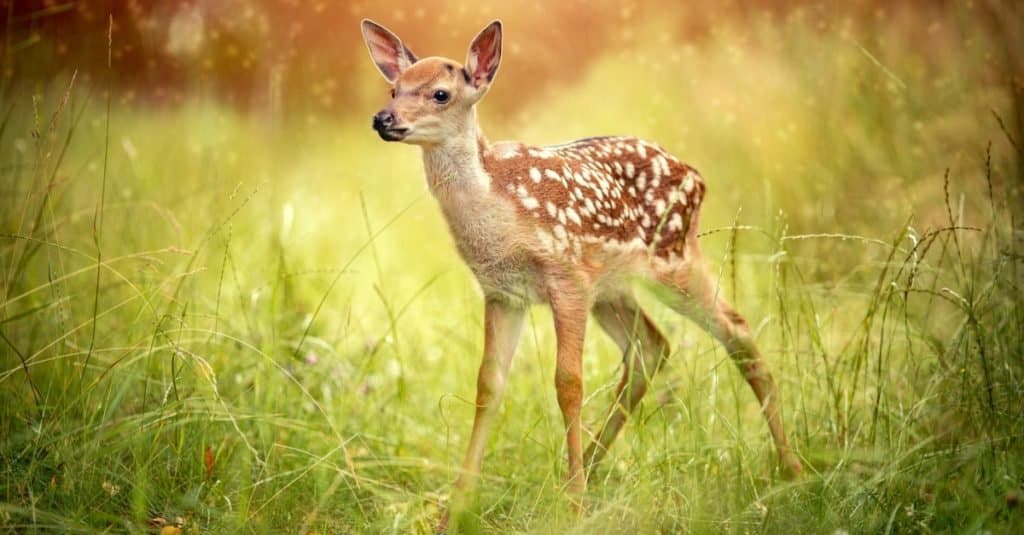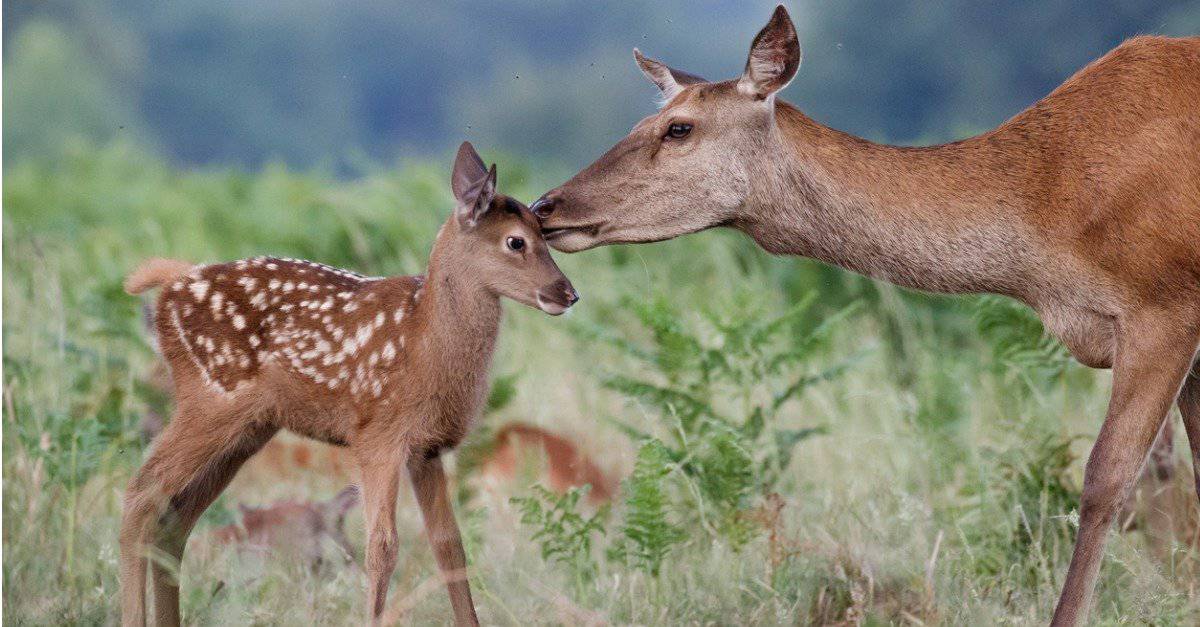Deer are graceful and elegant animals that belong to the family Cervidae. They have slender, muscular bodies with long legs that allow them to run at high speeds when they need to escape from danger. Their coat is typically brown in color, although it can vary depending on the species and time of year. Some deer have white spots or patches on their fur, while others have a darker stripe running down their back.
One of the most distinctive features of deer is their antlers, which are used by males during mating season to establish dominance over other males and attract mates. Depending on the species, these antlers can grow up to three feet in length and weigh as much as 40 pounds! Female deer do not usually have antlers but may still possess small bony protrusions called pedicles.
Deer also have large ears and eyes positioned towards the sides of their head, allowing them panoramic vision so they can spot predators coming from any direction. They use their sense of smell just as extensively for detecting danger or finding food.
Overall, deer are magnificent creatures that inhabit forests across North America, Europe, Asia, and Africa. They are admired for both their beauty as well as their role in balancing ecosystems through herbivorous feeding habits.
When Do Deer Have Babies?
Deer typically give birth during the mid to late spring, with peak birthing season occurring in May and June. During this time, female deer, or does, will seek out secluded areas to give birth to their fawns. This is often a dense thicket or forested area that provides ample cover from predators.
The timing of deer births can vary depending on several factors, such as location, climate conditions, and availability of food sources. In warmer climates where food is readily available year-round, deer may give birth earlier in the year, while in colder climates, they may wait until later in the spring when resources are more abundant.
In general, though, if you’re looking for signs of new fawns within your local deer population, then keep an eye out starting around April through August. Pregnant deer can be spotted by their swollen bellies and a noticeable change in behavior as they become increasingly protective of their unborn young. Once born, fawns are usually easy to spot due to their distinctive spots, which help them blend into their surroundings and avoid detection from predators.
Reproduction
Deer are fascinating creatures, and understanding their reproduction habits can help us appreciate the beauty of nature. As we delve into deer reproduction, it’s important to note that the mating season varies depending on the species and geographic location. In general, however, most deer species mate in late fall or early winter.
During this time, males become more aggressive and territorial as they compete for females’ attention. The bucks will use their antlers to fight off other males while attempting to attract a mate through calls and visual displays such as scraping trees with their hooves.
Once a male has successfully won over a female, he will mount her for breeding. The gestation period for deer lasts between 195-205 days before giving birth in the mid-spring.
It’s worth noting that some species of deer have unique reproductive behaviors. For example, mule deer often form small groups during the mating season rather than competing individually, as white-tailed deer do.
Overall, learning about how these majestic animals reproduce can deepen our appreciation for them and help us better understand the wildlife conservation efforts needed to protect them from environmental threats.
All About Baby Deer
If you’re curious about baby deer, there’s a lot to learn! Fawns, or baby deer, are typically born in the late spring and early summer months. Deer have a gestation period of around 200 days, so fawns are usually born between May and June. Deer most often have only one baby at a time, but they can have twins or even triplets.
When they’re first born, fawns weigh only around 5-8 pounds and are covered in white spots that help them blend into their surroundings and avoid predators. They rely on their mothers for milk for the first few weeks of life before transitioning to solid food. A doe will nurse her babies 4 or 5 times per day for the first four months of life, even after they have started grazing on grasses. The young deer learn from their mother which plants are safe to eat.
Fawns grow quickly. Within just a few months, they can weigh up to 60-70 pounds! During this time, they’ll start venturing out on their own more often but will still stay close to their mother for protection. Female deer often stay in the same herd as their mothers for a lifetime. Male deer are more likely to venture off alone or join a herd of males after they turn two years old.
While fawns may look cute and innocent, it’s important to remember that they are wild animals. If you come across one while hiking or in your backyard, it’s best not to touch or approach them as this can cause stress for both the fawn and its mother. Often, mothers will leave their fawns in the long grass to hide while the mother goes out to graze. Always leave unattended fawns alone! They have not been abandoned. If you see a fawn wandering around alone and bleating for its mother or getting close to a buy roadway – now it is time to get involved.

Within just a few months, they can weigh up to 60-70 pounds!
©gudfoto/Shutterstock.com
Deer Sounds
Deer are known to communicate through various sounds that serve different purposes. The four main types of sounds that deer make are maternal, alarm, distress, and reproductive calls.
Alarm – Alarm calls act as warning signals for other deer in the vicinity when they sense a potential danger or threat. When surprised or frightened, a deer may let out a snort by expelling air rapidly from its nostrils. This type of communication means, “I see something suspicious.”
Maternal – On the other hand, maternal communication involves low grunts made by does to their fawns. This communication helps maintain contact between the mother and young ones and fosters a close pair bond between them. Fawns respond with high-pitched mew-like sounds to these grunts while using bleats to get attention from their mothers.
Mating – During breeding seasons, bucks use grunt sounds while searching for receptive does and tending to them. They also advertise their presence and attract prospective does or rival bucks with varying pitches and volumes of grunts.
Distress – However, there is another type of sound that adult deer or young fawns make when captured by predators or trapped – bleating or groaning noises which signal distress that can alert nearby does who might come rushing at the aid of the distressed animal. This call clearly means, “Send help!”
In conclusion, understanding deer vocalizations is essential in learning about how these animals communicate with each other for survival during different life stages like reproduction and parenting, as well as establishing social relationships within their herds.
How to Help Deer
As homeowners, there are several things we can do to help the local deer population. Firstly, it is important to provide them with a safe and comfortable habitat. This means preserving natural areas on our property, such as wooded patches or wetlands, that they can use for shelter and food.
Secondly, we should avoid using pesticides or other harmful chemicals in our gardens and yards. These substances not only harm the deer directly but also damage their food sources which can lead to starvation.
Thirdly, it is important to be mindful of our driving habits, especially during peak deer mating season when they are more active and prone to crossing roads. We should drive slowly in areas where there may be deer crossings and always keep an eye out for these beautiful animals.
Lastly, if you want to go above and beyond in helping the local deer population, you could consider planting native plants that attract them or even creating a small feeding station (with proper permits if required) during harsh winter months when finding food becomes difficult for them.
What Not To Do
It is crucial to understand the importance of feeding deer without letting them associate the food with humans. While it may seem harmless and even fun to feed these beautiful creatures, it could lead to devastating consequences if not done in a responsible manner. If deer become accustomed to being fed by humans, they lose their natural fear of people and begin approaching them for food more frequently. If they approach the wrong person, this can lead to disaster.
This behavior can be dangerous for both the deer and humans alike. When deer are habituated to human presence, they tend to venture into populated areas more often, which increases their risk of getting hit by vehicles or becoming prey for predators. They are also more likely to congregate in higher numbers, which encourages the spread of disease, leading to unnecessary deaths.
Therefore, it is essential that any person who wants to help deer should do so responsibly by avoiding direct interaction with them while providing necessary nourishment like hay during harsh winters or other challenging times. It’s also important not only when but where you feed them as well. Try placing food in areas away from human activity and nowhere near a paved road.
In conclusion, supporting wild animals such as deer needs thoughtful consideration and care because our actions impact their lives significantly. By respecting nature’s boundaries and keeping wildlife at arm’s length while still providing critical support when needed – we can create a healthy balance between nature and ourselves while ensuring the safety of all involved parties!
Thank you for reading! Have some feedback for us? Contact the AZ Animals editorial team.








